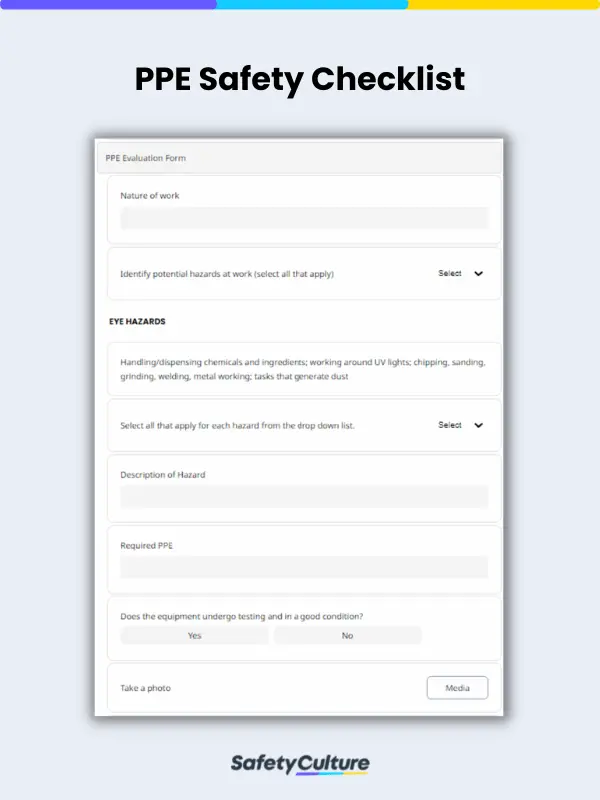What are PPE Inspection Checklists?
Personal Protective Equipment (PPE) inspection checklists are used by safety officials and supervisors to help identify tasks that require PPE, ensure staff is using the right equipment, and reduce overall harm. Inspections ensure that all PPE are of the correct specification and fitting, which also helps identify the “weakest link” in a safety and risk prevention program. Regular PPE inspections are vital to every organization involved in hazardous industries because PPE can become damaged or lose its effectiveness due to wear and tear, improper use and handling, and exposure to dirt, grit, chemicals, and other elements. Inspections ensure compliance and that PPE will last for a long time with minimum degradation.
Importance and Benefits of Using this Checklist
Regular PPE inspections are critical for complying with safety regulations and standards. Employers are responsible for providing a safe working environment, and PPE inspections are a fundamental part of this obligation. Here are some of the benefits of conducting a PPE inspection:
Detecting Wear and Tear
Over time, PPE can wear out or become damaged. Inspection checklists help identify worn-out or damaged items, allowing for timely replacements and thus ensuring that employees are adequately protected.
Extending Equipment Lifespan and Cost Savings
Proper maintenance and inspection can extend the lifespan of PPE, reducing the overall cost of replacements and contributing to long-term cost savings. Preventive maintenance through inspections can result in significant cost savings. It prevents workplace accidents, injuries, and illnesses that may lead to medical expenses, worker compensation claims, and legal liabilities.
Ensuring Legal Compliance
Neglecting PPE inspections can lead to legal consequences. Non-compliance with safety regulations can result in fines and legal actions. A PPE inspection checklist helps companies avoid these legal complications.
What are the Maintenance Requirements for PPE?
Proper maintenance of PPE, unfortunately, is something that can still fall through the cracks if companies aren’t careful. It’s a consideration that should always be a top priority, especially for companies in hazardous industries like construction. Below are the main considerations in the proper maintenance of PPE.
For helmets:
- Keep helmets clean by regularly washing them with warm water and soap.
- Check headbands to ensure a comfortable fit.
- Store helmets and other head protection gear away from extreme temperatures and conditions.
- Replace helmets that are cracked, have dents, or are showing signs of wear and tear.
For protective eyewear:
- Regularly clean eyewear with water and mild soap.
- Always wash lenses with water before wiping them to prevent scratches caused by foreign objects.
- Store eyewear in a durable dustproof case and keep in a safe place to avoid damage.
- Replace any eyewear immediately if they are pitted, scratched, or worn out to the point that they impair vision.
For gloves:
- Always keep gloves clean and dry.
- Always check gloves for holes, cracks, and other damage before use.
- Ensure whether gloves are reusable or not and, if reusable, take note of how long they can be reused safely before requiring replacement.
- Replace damaged or worn gloves immediately.
For footwear:
- Wipe wet or soiled footwear with a clean cloth before storage.
- Air out footwear after work to keep dry.
- Regularly check for signs of mold and fungus.
- Users of protective footwear should change socks during breaks to keep feet and footwear dry.
- Replace footwear at the first sign of damage and regularly check ones in use to ensure they are in good working condition.
General Employer Responsibilities for PPE
There has been growing awareness and focus on the proper use of PPE, but even if workers in hazardous industries are trained on their proper usage, there’s still the problem of proper care and maintenance. Even if workers wear PPE at all times during working or when exposed to certain hazards, this diligence means nothing if the PPE used has deteriorated or isn’t up to quality standards. In the US, OSHA puts the responsibility of ensuring workers are protected from harm and that PPE is always maintained on the employer’s shoulders. Aside from PPE maintenance, employers are also responsible for:
- performing a hazard assessment of the workplace to identify and control hazards;
- identifying and providing appropriate PPE to employees;
- training employees in the use and care of PPE; and
- periodically reviewing, updating, and evaluating the effectiveness of the PPE program.
Frequently Asked Questions (FAQs) about PPE Inspections
The frequency of PPE inspections varies depending on the type of equipment and the work environment. High-risk environments may require daily inspections, while lower-risk settings may suffice with weekly or monthly checks.
PPE inspections should be carried out by trained personnel who are knowledgeable about the standards and requirements for inspecting different types of protective equipment. This responsibility is often assigned to designated safety officers or supervisors.
Proper training and education are essential to ensure that employees understand the importance of PPE and how to use it correctly. Regular training sessions and clear guidelines can promote safe and effective usage of protective equipment.
If damaged or faulty PPE is identified during an inspection, it should be immediately taken out of service and replaced. Repairs should be made only by qualified personnel, and the equipment should not be used until it’s restored to a safe condition.



